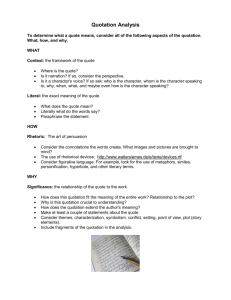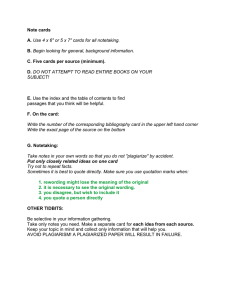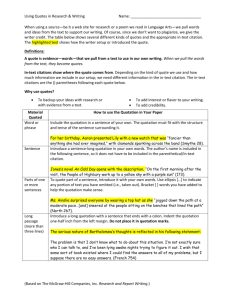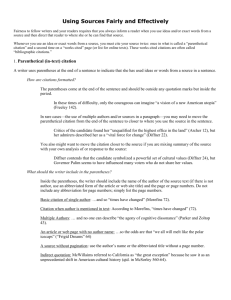MLA Format Rules for Writing Research Papers
advertisement
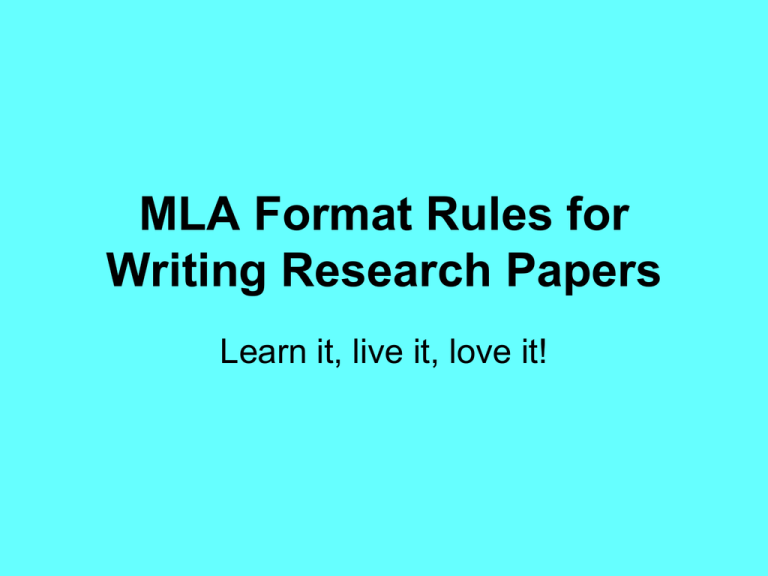
MLA Format Rules for Writing Research Papers Learn it, live it, love it! First page • Double spaced, Times New Roman or Calibri font size 11 or 12, One inch margins on all sides – Four line heading, upper left corner: • • • • • Your name Teacher’s name Title of the course Date due: 8 December 2014 Double spaced • Title of paper centered on next line after heading Running head • Upper right-hand corner of each page of your research paper including your “Works Cited” page. • Includes YOUR last name and the page number of the paper • Page number changes for each consecutive page of your paper • Go to Insert “headers and footers” to input your running head in the “header” of your pages. Typical citation for including research in your writing: • Direct quote: – Lines to be directly quoted (taken word for word from your source) must be placed inside quotation marks. – For direct quotes of less than four typed lines, you must place the citation directly after the quote. You need to include the author’s last name/editor’s last name/keyword from the source and the page number that the information appears on from your source. Example of a citation for a direct quotation: • Arthur Miller’s The Crucible “forces a revolution in our perception and definition of reality” (Martin 73). • The period for the end of the sentence goes after the parentheses. • If there is no author, use the editor of the source inside the parentheses. Block Quote: • • • • To be used for direct quotes only. Must be at least 4 lines or more. Quotation is introduced by a colon (:) Entire quotation starts on a new line and is indented 10 spaces (tab 2x) from left-hand margin. • The citation must come immediately after the quotation and no quotation marks are needed for a block quote. • The period comes before the parentheses in a block quote. Example of Block Quote: Wages are so low, and jobs were so few, that thousands of migrants were driven to desperate poverty. The extent of the desperation is made clear in a report written in 1939, the year that The Grapes of Wrath was published: The State Relief Administration estimates the most agricultural workers only have employment for six months in the year of less; and that the average yearly earnings per family…[were] $289 in 1935. In the same study the S.R.A. estimated that each family…should have had at least $780 to eke out an existence…In 1932 there were 181 agricultural workers for every 100 jobs offered; in …1934, 142. (McWilliams 48) Then continue the paragraph as you normally would on a new line. Works Cited Page • The works cited page lists only sources that you actually used (there are citations for) in the text of your research paper. • https://owl.english.purdue.edu/owl/resource/747/ 12/ • The sources are listed in alphabetical order based on whatever comes first in the citation. • A very credible website for MLA format information: https://owl.english.purdue.edu/owl/resource/747/1/ Paraphrasing • Paraphrasing means that you are putting the information from the source into your own words. • You still need to cite where the information came from even if you are paraphrasing. • The citation is the same for direct quote. • You will cite after you are finished paraphrasing from a particular source at that point in your paper. This does not mean that you can’t use it somewhere else in your paper, but you need to cite it again, each time you use it, paraphrased or directly quoted. Reminders: • Each time you use a particular source, the citation for it must be the same except the page number may change. • There is no need to use a “p.” or “pg.” in front of the page number in the parentheses. Just use the number alone. • Avoid “overquoting.” It is important to use your own voice. • Please no cover pages or report covers needed. Your work is beautiful enough without this extra stuff!!! So, use in-text documentation to cite a source whenever you: • Use an original idea from one of your sources, whether you quote or paraphrase it. • Summarize original ideas from one of your sources. • Use factual information that is not common knowledge • Quote directly from the source. Use quotations when: • You want to add the power of an author’s words to support your argument • You want to disagree with an author’s argument. • You want to highlight particularly eloquent or powerful phrases or passages. • You are comparing and contrasting specific points of view. Little reminders for research simulated tasks: • Underline or italicize book/play titles/magazine titles. Once you choose one method, stick with it. • Quotation marks go around articles titles. • Never use a quotation as a topic sentence! • Avoid “I think/I believe” and the worst offender, “You”! • Your thesis statement should answer the question. Make sure this sentence is something arguable.


